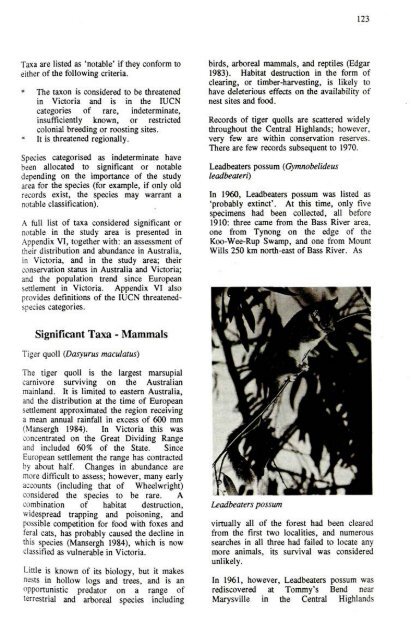Factors Affecting Flora Conservation - Victorian Environmental ...
Factors Affecting Flora Conservation - Victorian Environmental ...
Factors Affecting Flora Conservation - Victorian Environmental ...
Create successful ePaper yourself
Turn your PDF publications into a flip-book with our unique Google optimized e-Paper software.
123<br />
Taxa are listed as 'notable' if they conform to<br />
either of the following criteria.<br />
* The taxon is considered to be threatened<br />
in Victoria and is in the lUCN<br />
categories of rare, indeterminate,<br />
insufficiently known, or restricted<br />
colonial breeding or rtwsting sites.<br />
* It is threatened regionally.<br />
Species categorised as indeterminate have<br />
been allocated to significant or notable<br />
depending on the importance of the study<br />
area for the species (for example, if only old<br />
records exist, the species may wartant a<br />
notable classification).<br />
A full list of taxa considered significant or<br />
notable in the study area is presented in<br />
Appendix VI, together with: an assessment of<br />
their distribution and abundance in Australia,<br />
in Victoria, and in the study area; their<br />
conservation status in Australia and Victoria;<br />
and the population trend since European<br />
settlement in Victoria. Appendix VI also<br />
provides definitions of the lUCN threatenedspecies<br />
categories.<br />
birds, arboreal mammals, and reptUes (Edgar<br />
1983). Habitat destmction in the form of<br />
clearing, or timber-harvesting, is likely to<br />
have deleterious effects on the avaUability of<br />
nest sites and food.<br />
Records of tiger quolls are scattered widely<br />
throughout the Cenfral Highlands; however,<br />
very few are within conservation reserves.<br />
There are few records subsequent to 1970.<br />
Leadbeaters possum (Gymnobelideus<br />
leadbeateri)<br />
In 1960, Leadbeaters possum was listed as<br />
'probably extinct'. At this fime, only five<br />
specimens had been collected, all before<br />
1910; three came from the Bass River area,<br />
one from Tynong on the edge of the<br />
Koo-Wee-Rup Swamp, and one from Mount<br />
WUls 250 km north-east of Bass River. As<br />
Significant Taxa - Mammals<br />
Tiger quoll (Dasyurus maculatus)<br />
The tiger quoll is the largest marsupial<br />
carnivore surviving on the Australian<br />
mainland. It is limited to eastern Australia,<br />
and the distribution at the time of European<br />
settlement approximated the region receiving<br />
a mean annual rainfall in excess of 600 mm<br />
(Mansergh 1984). In Victoria this was<br />
concentrated on the Great Dividing Range<br />
and included 60% of the State. Since<br />
European settlement the range has contracted<br />
by about half. Changes in abundance are<br />
more diftlcult to assess; however, many early<br />
accounts (including that of Wheelwright)<br />
considered the species to be rare. A<br />
combination of habitat destmction,<br />
widespread trapping and poisoning, and<br />
possible competition for f(xxi with foxes and<br />
feral cats, has probably caused the decline in<br />
this species (Mansergh 1984), which is now<br />
classified as vulnerable in Victoria.<br />
Little is known of its biology, but it makes<br />
nests in hollow logs and trees, and is an<br />
opportunistic predator on a range of<br />
terrestrial and arlwreal species including<br />
i:<br />
Leadbeaters possum<br />
virtually all of the forest had been cleared<br />
from the first two localities, and numerous<br />
searches in all three had failed to locate any<br />
more animals, its survival was considered<br />
unlikely.<br />
In 1961, however, Leadbeaters possum was<br />
rediscovered at Tommy's Bend near<br />
MarysviUe in the Central Highlands
















